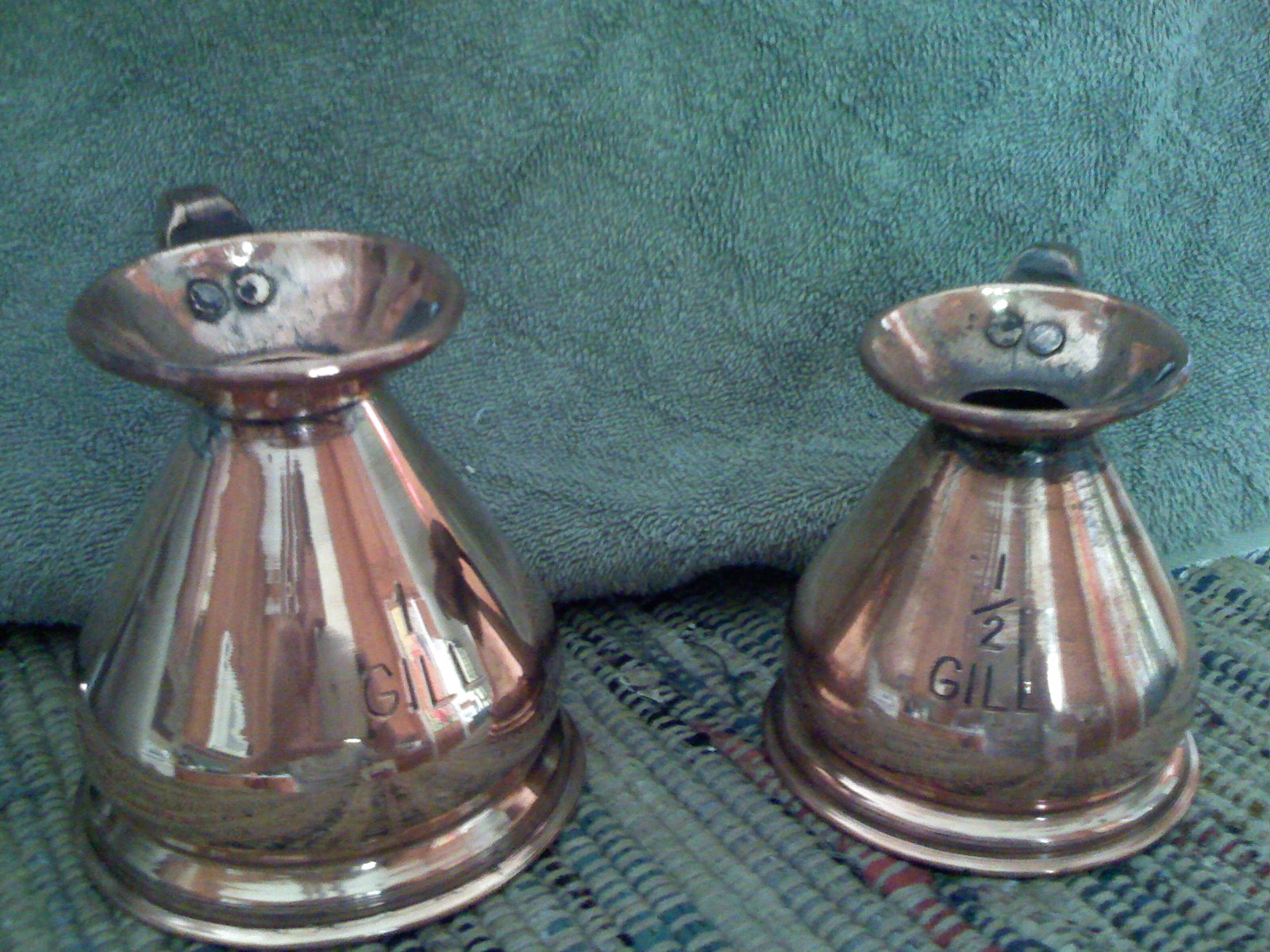|
Quart
The quart (symbol: qt) is a unit of volume equal to a quarter of a gallon. Three kinds of quarts are currently used: the liquid quart and dry quart of the US customary system and the of the British imperial system. All are roughly equal to one liter. It is divided into two pints or (in the US) four cups. Historically, the size of a quart has varied with the different values of gallons over time, and in the case of the dry quart, in reference to different commodities. Name The term comes from the Latin Latin ( or ) is a classical language belonging to the Italic languages, Italic branch of the Indo-European languages. Latin was originally spoken by the Latins (Italic tribe), Latins in Latium (now known as Lazio), the lower Tiber area aroun ... (meaning one-quarter) via the French . However, although the French word has the same root, it frequently means something entirely different. In Canadian French in particular, the quart is called , while the pint ... [...More Info...] [...Related Items...] OR: [Wikipedia] [Google] [Baidu] |
US Customary System
United States customary units form a system of measurement units commonly used in the United States and most U.S. territories since being standardized and adopted in 1832. The United States customary system developed from English units that were in use in the British Empire before the U.S. became an independent country. The United Kingdom's system of measures evolved by 1824 to create the imperial system (with imperial units), which was officially adopted in 1826, changing the definitions of some of its units. Consequently, while many U.S. units are essentially similar to their imperial counterparts, there are noticeable differences between the systems. The majority of U.S. customary units were redefined in terms of the meter and kilogram with the Mendenhall Order of 1893 and, in practice, for many years before. T.C. Mendenhall, Superintendent of Standard Weights and MeasuresOrder of April 5, 1893, published as Appendix 6 to the Report for 1893 of the United States Coa ... [...More Info...] [...Related Items...] OR: [Wikipedia] [Google] [Baidu] |
Pint
The pint (, ; symbol pt, sometimes abbreviated as ''p'') is a unit of volume or capacity in both the imperial and United States customary measurement systems. In both of those systems, it is one-eighth of a gallon. The British imperial pint is 20.095% larger than the US pint because the two systems are defined differently. Almost all other countries have standardized on the metric system, so although some of them still also have traditional units called pints (such as for beverages), the volume varies by regional custom. The imperial pint (≈) is used in Ireland, the United Kingdom, and other Commonwealth countries. In the United States, two kinds of pint are used: a liquid pint (≈) and a less common dry pint (≈). Other former British colonies, such as Australia, South Africa and New Zealand, converted to the metric system in the 1960s and 1970s, so while the term may still be in common use in these countries, it may no longer refer to the British imperial pint once ... [...More Info...] [...Related Items...] OR: [Wikipedia] [Google] [Baidu] |
Gallon
The gallon is a unit of volume in British imperial units and United States customary units. The imperial gallon (imp gal) is defined as , and is or was used in the United Kingdom and its former colonies, including Ireland, Canada, Australia, New Zealand, India, South Africa, Malaysia and some Caribbean countries, while the US gallon (US gal) is defined as , and is used in the United States and some Latin American and Caribbean countries. There are four gills in a pint, two pints in a quart, and four quarts (''quarter'' gallons) in a gallon, with the imperial gill being divided into five imperial fluid ounces and the US gill being divided into four US fluid ounces: this, and a slight difference in the sizes of the imperial fluid ounce and the US fluid ounce, give different sizes for the imperial gallon and US gallon. The IEEE standard symbol for both the imperial and US gallons is gal, not to be confused with the gal (symbol: Gal), a CGS unit of acceleration. Definitions ... [...More Info...] [...Related Items...] OR: [Wikipedia] [Google] [Baidu] |
Imperial Unit
The imperial system of units, imperial system or imperial units (also known as British Imperial or Exchequer Standards of 1826) is the system of units first defined in the British Weights and Measures Act 1824 and continued to be developed through a series of Weights and Measures Acts and amendments. The imperial system developed from earlier English units as did the Comparison of the imperial and US customary measurement systems, related but differing system of United States customary units, customary units of the United States. The imperial units replaced the Winchester measure, Winchester Standards, which were in effect from 1588 to 1825. The system came into official use across the British Empire in 1826. By the late 20th century, most nations of the former empire had metrication, officially adopted the metric system as their main system of measurement, but imperial units are still used alongside metric units in the United Kingdom and in some other parts of the former empi ... [...More Info...] [...Related Items...] OR: [Wikipedia] [Google] [Baidu] |
Gill (unit)
__NOTOC__ The gill or teacup is a unit of measurement for volume equal to a quarter of a pint. It is no longer in common use, except in regard to the volume of alcoholic spirits measures. Imperial ;In imperial units: : US ;In United States customary units: : United Kingdom Prior to metrication in the United Kingdom, the standard single measure of spirits in a pub was in England and Wales, either or in Scotland, and in Northern Ireland. After metrication, this was replaced by measures of either , at the discretion of the proprietor. Half of a gill is a jack, or one-eighth of a pint. But in northern England, a quarter pint could also be called a jack or a noggin, rather than a gill, and in some areas a half-pint could be called a gill, particularly for beer and milk. In Scotland, there were additional sizes: * big gill = * wee gill = * wee half gill = * nip = Ireland In the republic of Ireland, the standard spirit measure was historically gill. It stil ... [...More Info...] [...Related Items...] OR: [Wikipedia] [Google] [Baidu] |
Winchester Measure
Winchester measure is a set of legal standards of volume instituted in the late 15th century (1495) by King Henry VII of England and in use, with some modifications, until the present day. It consists of the Winchester bushel and its dependent quantities, the peck, (dry) gallon and (dry) quart. They would later become known as the Winchester Standards, named because the examples were kept in the city of Winchester. Winchester measure may also refer to: * the systems of weights and measures used in the Kingdom of Wessex during the Anglo-Saxon period, later adopted as the national standards of England, as well as the physical standards (prototypes) associated with these systems of units * a set of avoirdupois weight standards dating to the mid-14th century, in particular, the 56-pound standard commissioned by King Edward III, which served as the prototype for Queen Elizabeth I's reform of the avoirdupois weight system in 1588 * a type of glass bottle, usually amb ... [...More Info...] [...Related Items...] OR: [Wikipedia] [Google] [Baidu] |
Fifth (unit)
A fifth is a unit of measurement, unit of volume formerly used for Wine bottle, wine and distilled beverages in the United States, equal to one fifth of a gallon#US liquid gallon, US liquid gallon, or ; it has been superseded by the metric system, metric bottle size of 750 mL, sometimes called a metric fifth, which is the standard capacity of wine bottles worldwide and is approximately 1% smaller. History Before the mid-19th century, the capacity of British alcohol bottles used for wine and distilled liquors was nominally a quart, but the actual capacity varied considerably. Four primary styles existed, with different average capacities: 759 ± 27 mL (715–810 range); 781 ± 47 mL (724–880); 808 ± 49 mL (739–835); and approximately 1130 mL, the "imperial wine quart". Beer and cider bottles had a different range of sizes. In 1842, it was reported that ordinary wine bottles were 1/6 of an imperial gallon, that is, 758 mL. After its indep ... [...More Info...] [...Related Items...] OR: [Wikipedia] [Google] [Baidu] |
Liter
The litre ( Commonwealth spelling) or liter ( American spelling) (SI symbols L and l, other symbol used: ℓ) is a metric unit of volume. It is equal to 1 cubic decimetre (dm3), 1000 cubic centimetres (cm3) or 0.001 cubic metres (m3). A cubic decimetre (or litre) occupies a volume of (see figure) and is thus equal to one-thousandth of a cubic metre. The original French metric system used the litre as a base unit. The word ''litre'' is derived from an older French unit, the '' litron'', whose name came from Byzantine Greek—where it was a unit of weight, not volume—via Late Medieval Latin, and which equalled approximately 0.831 litres. The litre was also used in several subsequent versions of the metric system and is accepted for use with the SI, despite it not being an SI unit. The SI unit of volume is the cubic metre (m3). The spelling used by the International Bureau of Weights and Measures is "litre", [...More Info...] [...Related Items...] OR: [Wikipedia] [Google] [Baidu] |
Fluid Ounce
A fluid ounce (abbreviated fl oz, fl. oz. or oz. fl., old forms ℥, fl ℥, f℥, ƒ ℥) is a unit of volume (also called ''capacity'') typically used for measuring liquids. The British Imperial, the United States customary, and the United States food labeling fluid ounce are the three that are still in common use, although various definitions have been used throughout history. An imperial fluid ounce is of an imperial pint, of an imperial gallon, or exactly 28.4130625 mL. A US customary fluid ounce is of a US liquid pint, of a US gallon, or exactly 29.5735295625 mL, making it about 4.084% larger than the imperial fluid ounce. A US food labeling fluid ounce is exactly 30 mL. Comparison to the ounce The ''fluid'' ounce is distinct from the (international avoirdupois) ounce as a unit of weight or mass, although it is sometimes referred to simply as an "ounce" where context makes the meaning clear (e.g., "ounces in a bottle"). A volume of pure water me ... [...More Info...] [...Related Items...] OR: [Wikipedia] [Google] [Baidu] |
Peck
A peck is an imperial and United States customary unit of dry volume, equivalent to 8 dry quarts or 16 dry pints. An imperial peck is equivalent to 9.09218 liters and a US customary peck is equivalent to 8.80976754172 liters. Four pecks make a bushel. Although the peck is no longer widely used, some produce, such as apples, are still often sold by the peck in the U.S. (although it is obsolete in the UK, found only in the old nursery rhyme " Peter Piper" and in the Bible – e.g., Matthew 5:15 in some older translations). Scotland before 1824 In Scotland, the peck was used as a dry measure until the introduction of imperial units as a result of the Weights and Measures Act 1824. The peck was equal to about 9 litres (1.98 Imp gal) (in the case of certain crops, such as wheat, peas, beans and meal) and about 13 litres (2.86 Imp gal) (in the case of barley, oats and malt). A firlot was equal to 4 pecks. Conversions See also * Bushel A bushel (abbreviation: bs ... [...More Info...] [...Related Items...] OR: [Wikipedia] [Google] [Baidu] |




